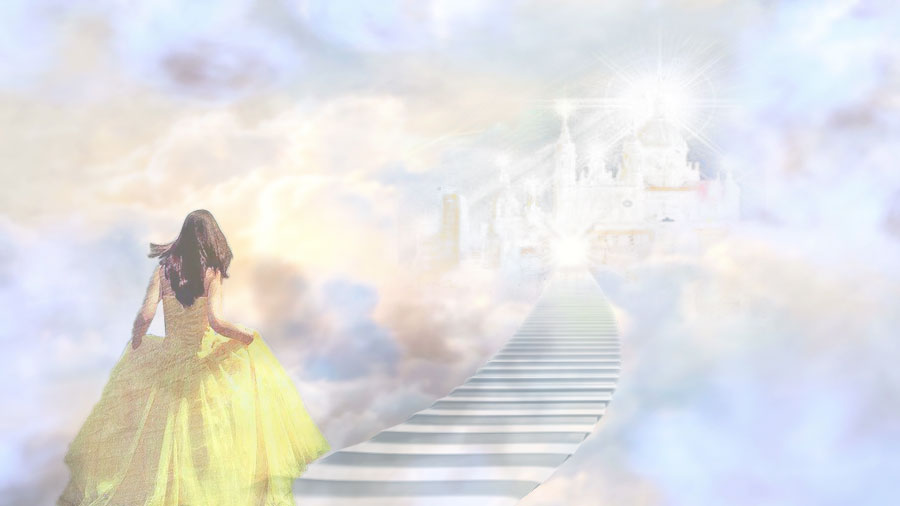Revelations Of The Afterlife
 by Arthur Ford
by Arthur Ford
Arthur Ford (1896-1971), an ordained minister, also psychic medium, reports here the case of Frederic Myers, the bulk of whose discourse was communicated though an Irish girl, Geraldine Cummins through automatic writing.
If we are to grasp the full import of Myers’ message, it would be well to review at this point the concept which, though never specifically stated by him, permeates the whole of his communication—evolution-of-consciousness or post-Darwinian evolutionary theory. According to this hypothesis, as developed during the twentieth century by Bergson, Bucke, Julian Huxley, Teihard, Jung, Medawar, and others, the main thrust of evolution is to develop an increasing capacity for breadth and depth of awareness, with the multiplicity of physical forms a mere by-product of this central evolutionary drive.
Earthworms, clams, and barnacles, possessing “simple consciousness” live in a dim dream, living out their lives in a few cubic feet of earth space, dimly aware of light, dark, heat, cold, hunger, and a need to reproduce. On the reptile, bird, and animal scale, consciousness ascends through a hierarchy of awareness of increasing range. In the human world, the outstanding feature of progression from infancy to adulthood is an extension of the range of things the individual can be aware of. When adulthood is achieved, there still remain vast differences in capacities for—”levels of”—awareness. The consciousness of woman A may be limited to husband, house, children, and shopping centers, while the mind of woman B may encompass all these things and also an appreciation of music, an interest in books, participation in local politics.
The awareness levels of both women may change. Woman A may suddenly develop an interest in religion which may open her eyes to the predicament of the entire human species and set her off on a serious study of international affairs. Woman B may, in addition to her present interests, develop an intense concern for social justice and thus increase her understanding of social machinery. Both women will have, on this present earth plane, to use a phrase frequently employed by Myers, “progressed to a higher level of consciousness.” Similarly, the man obsessed with stock market, family, and fishing may develop an interest in art and languages and thus expand his level of consciousness without ever leaving the earth plane.
The Myers communications assert that the evolutionary thrust toward ever-expanding awareness is cosmic and eternal and hence does not stop at death. The main thrust of creation is not physical forms but mental ones, easily capable of casting off one physical form to take on another or existing in abundant, energetic life with no physical form at all. The wise human being on earth, if he has kept himself mentally alert, progresses toward wisdom through ever-widening and ever-deepening understanding of physical, mental, and spiritual principles.
So, Myers says, do we progress in the life beyond death. In the life on earth, as a byproduct of our growing consciousness, we take on and discard numerous bodies—those of infants, pre-adolescents, adolescents, young adults, mature adults, and several adult-body replacements. In the life beyond death, not only does the evolutionary thrust toward widening awareness continue, but it is also housed in a sequence of bodies. These life-beyond bodies, however, are made of lighter, finer, more highly energized materials, with an increasing content of mental-spiritual energy as the sequence progresses. The Creator Himself is conceived as pure creative thought-energies source—”The Great Imagination”.
Myers, after twenty years of “other-side” experience and observation, conceived the after-death life experience as divided into seven major stages, each with its entry phase, period of development, and period of preparation for the next higher stage. Stage One is, of course, the earth plane. Stage Two is the condition of the individual immediately after death. Myers refers to it variously as “The Life Immediately After Death,”
There follows Stage Four, an indescribably lovely existence called “The Plane of Color” or “The World of Eidos”. Highly qualified souls may or may not progress to “The Plane of Flame”or “The World of Helios,” which is Stage Five. The ultimate stages Six And Seven—”The Plane of Light” and “Timelessness”—are of an advanced spiritual nature, so close to the ultimate essence of creativity that no experience vocabulary has yet been evolved to describe them, and hence they are difficult to communicate to earth-level beings. The situation is roughly analogous to, but far more difficult than, that of the earth-side doctor trying to explain the action of the endocrine glands to a kindergarten child whose endocrine glands he is treating.
Myers illustrates this progression with case histories. There should be one further preliminary word before continuing Myers’ discourse: on reincarnation. At the time when Myers was writing, both on the earth plane and, through mediums, from the afterlife, the reincarnation theory was not given wide credence among Western psychologists, parapsychologists, and psychical researchers. Since then, and particularly in the light of the very recent investigations of the University of Virginia professor of psychology Ian Stevenson, the likelihood of reincarnation is being taken much more seriously. In this respect, as well as in evolution-of-consciousness theory, Myers proved himself well ahead of his time.
As Myers’ first case history, we may consider the instance of “Walter”. Walter was one of the four sons of a middle-class family able to live comfortably on the income produced by the father’s unimaginative and repetitious occupation. It was a “family-centered” family, dominated by a mother who found adequate life fulfillment in directing the affairs of her children, of whom she was very proud. The family was smug, proud, and aloof, considering themselves somewhat above the general run of humanity and entering hardly at all into human affairs outside the family circle.
Walter was a particular favorite of both his parents. He finally married, but the marriage had a brief life. Walter, so long accustomed to the unqualified praise heaped upon him by his mother, could not adjust to the presence of a woman who assessed him more realistically. There were bitter quarrels and finally a divorce. Walter returned to home and mother, and devoted his surplus energies to making money. An adroit stock manipulator, he was very successful and amassed a great deal of money. After the death of his mother and father, he moved to an expensive and well-appointed city club and there lived out the rest of his earth days enjoying the adulation the earth plane heaps upon the man who has a lot of money. Walter eventually died and entered Stage Two, the“Intermediate Plane”.
When a baby emerges from the fetus level of consciousness to earth awareness, he does a good deal of sleeping, dreaming, and resting, while people more accustomed to the earth plane attend to his needs, of which he is but dimly aware. So it is, says Myers, with the entry into Stage Two. In the tradition of folklore, people anticipating immediate death are said to have memories of their entire past lives flash before them. If this is true, it would seem to be a preview of Myers’ Intermediate Plane. During this interval Walter was, when not sleeping, in a resting state of drowsy reverie in which memory pictures of his past life floated through his mind. Apparently it is this state which is referred to in the ancient tradition of as “hell”. Whether or not it is “hellish”, of course, depends upon the memory content of the particular psyche. If this contains sinister episodes and terrifying experiences, these will drift by the dreamer’s vision along with the more joyful happenings. Myers designates this interval “The Journey Down the Long Gallery”.
During Walter’s sleepy journey down this memory path, he rediscovered his old affection for his mother and the pleasant, admiring protective glow of affection with which she had surrounded him. As he became stronger, and his imaginative force more potent, he found himself able to re-create an idealized version of the old home, the old hometown and—in cooperation with the still willing and still possessive psyche of his mother—lived happily among circumstances he considered ideal.
In Stage Three—”The Plane of Illusion” or “The Immediate World After Death”—materials are so pliable that they may be shaped by direct action of the imagination. They do not, as in the case of the recalcitrant materials of the earth plane, have to pass through the hands of draftsman, blue-printer, and workman. Walter now had no problems except an excess of time on his hands. Since he had always loved the old game of buying and selling stocks, he looked around for others who might like to play the game with him—and, of course, found them. As on earth, he was very successful and again made a great deal of money. Here, however, the gathering of money did not bring the same admiration and power it had on earth. Since any need could be gratified by the direct action of the imagination, there was no need of money, and few people cared much about it. This produced in Walter a feeling a disappointed restlessness. The feeling was intensified as he began to see that his mother’s love for him was childish and possessive. She was a child mother playing with her baby, a little girl playing with her doll.
Nor was his father’s admiration of him the same as it had been. The father was one of those who saw little point in making money in a place where it was not needed. Gradually Walter was brought face to face with the fact that, spiritually, he did not amount to much. Trapped between his father’s scorn and his mother’s suffocating possessiveness, he was driven to a frustrated rage. He felt he had to get out of there. The question was-to where? He longed more and more for the old days of excitement in the stock market, where he was the center of many admiring eyes. He began to feel what is called “the earth pull-the birth pull”. He regressed to Stage Two, where he again reviewed his past experience. There he made his decision to return to Stage One, the earth plane. He would be born again as a human baby as soon as appropriate parents could be found and would try again to see what he could learn from further experiences of earth life.
Walter had a brother named Martin who had been killed in a war many years before Walter’s death. There had also been a sister, Mary, who had died young. Mary and Martin had wider horizons than their brother Walter or their parents. Both had, through earth-life adventures that had taken them far outside the narrow preoccupations of the family circle, awakened in themselves the possibilities of a loving concern for all humanity.
They, too, after a period in the Stage Two dream rest, had returned to the imaginatively created old-hometown surroundings and enjoyed a family reunion. But their stay at this level of consciousness was brief. They quickly saw the limitations of housekeeping and stock trading, no mater how pleasantly these occupations might be idealized. They longed, not for return to earth life, but for greater awareness-increasing experiences in entirely new dimensions. And so they went on to the “Plane of Color” or “Eidos”.
Eventually, all the children gone, even father and mother began to reconsider the hometown situation. The mother, drawn back to earth by her attachment to Walter, would reenter Stage One as an earth baby. There, by living a life of wider awareness and generosity, she would redeem the damage her possessiveness had caused the last time around. The wavering father had no desire to return to earth. At last, with the anonymous help of Martin from Eidos, he was guided along a path that would lead him to strive for the next higher level of consciousness.
Not all experiences on the third plane, Myers says, are as stuffy as those described in the case of this family. The grouping urge, instead of being a family structure, may be a special interest, a religion, a profession, a trade, an art or almost anything that would join people in a joint exercise of their imaginations. Since communication is by direct-image telepathy, there are no language barriers. And since enthusiasms are no respecters of centuries, time is of little account. So it is perfectly possible for a soul to find itself part of a group containing people from other nations and from other centuries.
Though an individual may linger in Stage Three for generations, an eventual decision must be made: the individual either returns to earth or progresses to Stage Four. Before leaving, however, the more enterprising souls may have an opportunity to experience one of the great wonders of this plane of consciousness—a tour through some section of The Great Memory. Just as, on earth, one may go to a film library and see newsreels of important earth events since the invention of the motion-picture camera, so, in Stage Three, one may witness the originals of desire-selected events from the beginning of human experience. Everything that has ever happened has been recorded by the cosmic memory.
“I have journeyed only as far as Eidos, the Fourth Plane,” Myers wrote by the hand of Miss Cummins, “. . . so my knowledge is necessarily restricted.” Here, as on the earth plane, he sees himself as “an explorer” into the ultimate nature of human life and of the universe and of the relationships between the two. His clear, conscious aim is to penetrate as far as he can into the mystery being successively revealed to him, then, through sensitives, to send back word of newly discovered territories to “the collective mind of man”. Gradually he leads us to see a cosmic process at work. The traveler who will persevere in the arduous business of increasing the range of his sensitivity and understanding will, stage by stage, find himself growing in perception of ever more extensive ranges of the creative universe.
One receives an impression that it is the aim of the Creator to “take into the firm”, as junior partners, as many as can qualify. As soon as earth experience has been thoroughly comprehended—either through one or more return trips to that plane, or through exchange of experience with other travelers met on the third plane—the candidate may proceed to realms beyond the reach of the earth mind. “If you are a soul now,” Myers writes “—an intelligent ethically developed soul—you will desire to go up the ladder of consciousness. In most cases, the longing for a physical earth-existence will have been burned into ashes.”
Throughout Myers’ long series of discourses he emphasizes that what he is talking about is the actual experience of other modes of existence rather than mere theorizing about them. “Here on the Fourth Plane one must leave behind all rigid intellectual structures and dogmas, be they scientific, religious, or philosophical.” Myers is so insistent on this point that he subtitles the fourth plane “The Breaking of the Image”. On “The Plane of Color”, Myers finds himself for the first time having difficulty verbalizing in earth terms what he is experiencing. “A human being cannot imagine a new sound, a new color or feeling entirely outside the range of his previous experience. It is impossible for him to conceive the infinite variety of new sounds, colors and feelings experienced by us on the Fourth Plane.”
He can, however, communicate certain of its qualities. The demands of the earth body, the presuppositions of earth forms, the effects of their long imprint and conditioning, while still in memory, are now put far behind. A new and more highly energized intellect and spirit find a much wider freedom to function. This new energy requires a new body to give it expression and so creates one. It bears a faint resemblance to the old earth form, but is far more radiant and beautiful and better suited to its new employment. Myers continues:
“Flowers are there, but in shapes unknown to you, exquisite in color, radiant with light. Such colors and lights, not contained within any earthly octave, are expressed by us in thoughts and not in words. Words for us are obsolete. The soul, in this plane of consciousness, must struggle and labor, know sorrow but not earth sorrow. Know ecstasy but not earth ecstasy. Mind expresses itself more directly: we can hear the thoughts of other souls. Experience on the fourth plane leads the soul to the borders of the superterrestrial region.”
The main work on this plane is toward further understanding of how mind controls energy and life-force, from which all outward appearances emerge. Here one is free from the heavy mechanical restrictions of earth. “I have but to concentrate my thought for what you might call a moment,” Myers says, “and I can build up a likeness of myself, send that likeness speeding across our vast world to a friend, to one, that is, in tune with me. Instantly I appear before that friend, though I am remote from him. My likeness holds speech—in thought, remember, not words—with this friend. Yet, all the time, I control it from an enormous distance; and as soon as the interview is concluded I withdraw the life of my thought from that image of myself, and it vanishes.”
Since Myers had not progressed beyond the fourth plane at the time of his communication, his accounts of the higher levels of consciousness beyond this are less detailed and more speculative. He seems to have picked up enough hearsay, however, to outline with some confidence the general nature of the further advance.
A death experience and a rebirth are required, he says, as a transition from each stage to the next higher. It is assumed that on the fourth plane the intense experience of “profound despair and inconceivable bliss” has burned away the last vestiges of the cumbersome pettiness and animosities of earth, finally and completely freed the soul from domination by that planet. The spirit is now qualified to experience cosmic ranges beyond earth’s confines. In the fifth plane one acquires a body of flame, enabling him to tour the stellar universe without being harmed by its temperatures and turbulence and to return with a fuller experience of these cosmic reaches. The sixth plane is the “The Plane of Light”. Individuals on this plane are matured spirits, having lived through, with conscious comprehension, all the aspects of the created universe. Myers calls this “The Plane of White Light” and subtitles it “Pure Reason”. Souls on this plane are described as follows:
“They bear with them the wisdom of form, the incalculable secret wisdom, gathered only through limitation, harvested from numberless years, garnered from lives passed in myriad forms. …They are capable of living now without form, of existing as white light in the pure thought of their creator. They have joined the immortals . . . fulfilled the final purpose of the evolution of consciousness.”
The seventh stage—in which the soul enters full partnership with God—is beyond Myers’ verbal reach. It “baffles description; it is heartbreaking even to attempt to write of it”.
Myers knew that the levels of consciousness in the upper ranges were beyond the insight of the average earth dweller except for intuitive flashes. He gives us such detail about worlds beyond our reach, I believe, simply to assure us that there are such worlds. They are attainable to us and to our loved ones whenever the desire to attain them is strong enough. He wanted to remove from the human mind once and for all any fear of death with the assurance that there is no death, only alterations in mode of consciousness.
Excerpt from Other Worlds, Other Universes
See Part II here.
Posted in Life On The Other Side, Other Topicswith 2 comments.






yes-and regaring ‘7 levels of the afterlife’ mentioned here – I then thought of a book with such a title, “Seven Steps To Eternity”
by Stephen Turoff – a book from which I learned VERY much on life on the afterlife, and a book easy to read!
This account of the ‘ladder of awareness’ through many generations of life and after life resonated stunningly with me = its so realistic and logical — a ‘must read’ !